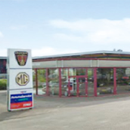V6 clutch renewal
Geschrieben am Monday, 09.July. @ 07:52:06 UTC by gert
 maathuis schreibt "I bought my ZT 190 at a mileage of 100.000 km and was quite happy with it, also as a towing car. But on a recent trip pulling a trailer with a T-Ford on it, 900 km from home in France, my clutch failed. Pulling of the motorway into a filling station, I heard a noise when pushing the clutch pedal. My immediate thought was that is was the clutch release bearing, but was not too worried, as I thought it might last till back home. We reached our destination for unloading the T-Ford, but then the clutch pedal when pushed stayed down, and did not come up again.
maathuis schreibt "I bought my ZT 190 at a mileage of 100.000 km and was quite happy with it, also as a towing car. But on a recent trip pulling a trailer with a T-Ford on it, 900 km from home in France, my clutch failed. Pulling of the motorway into a filling station, I heard a noise when pushing the clutch pedal. My immediate thought was that is was the clutch release bearing, but was not too worried, as I thought it might last till back home. We reached our destination for unloading the T-Ford, but then the clutch pedal when pushed stayed down, and did not come up again.
I looked under the bonnet to try to find the clutch master- or slave cylinder, but could not find any, so I supposed it was a cable-operated clutch. There was not much we could do and it was a Saturday night, so we would try to get home without a clutch on relatively empty French roads (no lorries on Sundays in France). I made some trials driving the ZT without the trailer and without a clutch. Starting with first gear engaged worked and careful gear changing by pulling the gearlever to neutral, then bringing the engine up to speed for the next gear, gently pushing the gearlever towards the next gear when it would jump in more or less without noise. So on Sunday morning we put the car on a slope, attached the trailer and made it home without breaking anything else.
At home I studied the workshop manual and found out, that the clutch is hydraulic and that the master cylinder sits on top of the clutch pedal, well hidden under the dashboard. So well hidden, that it is not possible to undo the lid, but I could see that it was empty. Even worse, the slave cylinder sits inside the bellhousing directly on the release bearing.
What had happened: The slave cylinder had started leaking and the fluid had ruined the release bearing. I could still disengage the clutch, until all the fluid had leaked out.
So the gearbox had to come out.
Further studying the workshop manual revealed, that to get the gearbox out you had to go as far as taking the front subframe of the car. I have a pit and a hoist, but this looked a bit much for me. After taking the aircleaner and battery case out of the car, as per workshop manual, I studied the layout and decided to try to get the gearbox out on itself. I contacted Roger Parker, but he did not give me much hope of being successful. I was going to try it anyhow.
So I proceeded up to paragraph 16, but from there on I am rewriting the workshop manual.
I put a sling around the gearbox in order to be able to move it about better.
I took the wheels off and undid the lower hub support. Amazing how rusty and stubborn these are on a 5 year old car. Make sure you grease them well on reassembly.
After unbolting the intermediate shaft support (item 23) this enabled me to pull the halfshafts out of the differential and block the wheelhubs and struts in this position. I ended up taking the lefthand one out all together to get more room for manoeuvring the gearbox.
I then followed again the workshop manual from item 28 onwards. Now, coming to item 41 one will find indeed, that the subframe prevents the gearbox from lowering.
Now comes the advantage of suspending the gearbox in a sling to its right: I was able to turn the box in the sling, such that the differential points downward. By playing a around with the jack supporting the engine, suddenly the box dropped out, almost on itself. Mission accomplished!
My diagnosis was correct and I ordered a new slave cylinder from my former MG Rover dealer, but was told not available. Furthermore I was told, that both slave and master cylinder are prefilled by the factory and connected with a quick release connection (see item 14 of the wsm). I found a new slave cylinder with Rimmer brothers, but decided to tackle the master cylinder myself. I took it out with some trouble to reach the tiny bolts on its backside, high-up under the dashboard, but that was nothing compared to refitting it after refilling. Later I found out that just filling it and hoping to bleed the system in the usual way is not possible, if alone because you cannot replenish the master cylinder in situe. You best leave it in place and with a syringe you push fluid in from the bottom bleednippel, until the mastercylinder is filled (or overflows, be careful).
Better would be to cut off the quick release coupling and the bleed extension from the old slave cylinder, attach this to the quick release coupling from the master cylinder and then bleed it in the same way. Doing it this way, you do not disturb the new prefilled slave cylinder, which is preloaded and held with plastic screws that break off the first time the clutch is applied.
In my case, I could not do this, because once I had joined the new slave to the old master, I did not manage to undo the coupling again. I do not know why, as the first time it was quite easy. So, do this straight away.
With both methods, it is advantageous to try to give the clutch fluid pipe a constant upward slope from the slave to the master cylinder. This will help to evacuate air bubbles to the master cylinder and even if you cannot get it all out straight away, with time it will find its way upwards and out of the system.
What else to say? Refitting is the reversal of the dismounting procedure, as usual.
Ah, yes, I drained the gearbox to see if there were bits of metal due to my clutchless gearchanging, but there were none. Now, the workshop manual lists three possible makes of gearbox oil, but none of the three was able to supply it. If only they could tell the specification, but even that was not possible. My MG Rover dealer said they would use 75/90 gearoil, so I did.
I hope this may help some owners to save a lot of money by attacking this job themselves.
MGreetings, Ton Maathuis (maathuis@internet.lu for additional information).
"
|
|
| |
| Artikel Bewertung |
durchschnittliche Punktzahl: 4.66
Stimmen: 6

|
|
|





